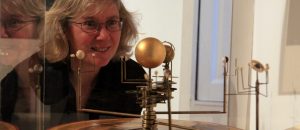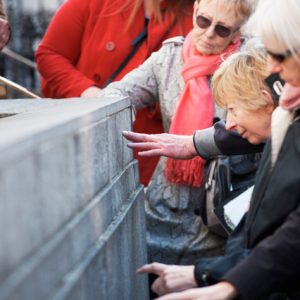Press release
People everywhere can now enjoy a famous ‘Eureka’ moment that took place in Cabra, beside Dublin’s Royal Canal in 1843. That moment was when a great mathematician and scientist, William Rowan Hamilton, had a spark of inspiration and invented a revolutionary new form of algebra.
Hamilton’s ‘quaternions’ turned the world of mathematics upside down, and a commemorative plaque marks the spot where he carved his equation in the stonework. Every year on the anniversary – October 16 – hundreds of people walk the canal from Dunsink to Broom Bridge, marking Quaternion Day, and this popular scientific pilgrimage attracts mathematicians, scientists and historians from around the world.
A new digital audio guided tour [launched October 28, 2011] makes this historic walk available to the public and schools, as well as internationally, and provides a new resource for heritage and science tourists. The audio was recorded on this year’s Hamilton walk, and includes contributions from visiting scientists, mathematicians and others, among them mathematician Dr Maurice O’Reilly, from St Patrick’s College Drumcondra, who said that
‘People in Ireland should know Hamilton’s equation, just like they know Yeats’s Lake Isle of Innisfree!’
The audio (or podcast) tour – ‘Quaternions by the Royal Canal’ – is free to download, thanks to support from Maths Week Ireland and the Irish Research Council for Science, Engineering and Technology (IRCSET). It tells the story of Hamilton and how his revolutionary algebra helped to land a man on the moon, as well as to control space satellites, and make sophisticated computer animations possible. The audio guide also features the history and heritage of the Royal Canal and railway, canal wildlife, and other canal-related science stories such as the discovery of the solitary wave (or, soliton).
IRCSET Director, Dr Martin Hynes, welcomed the new guide, which promotes greater awareness of science and Irish achievements. “The annual Hamilton walk, and other events during Maths Week every October show beyond doubt that there is huge public interest. It remains for us to nourish that interest, especially among young people, and foster their talents.” Interest, creativity and ingenuity, he said, will bring us to a new golden age.
Eoin Gill coordinator of Maths Week Ireland also welcomed the launch of the tour. “The story of Hamilton’s discovery of quaternions is one of the great stories of world mathematics and Ireland’s very own ‘Eureka story’. This audio guide celebrates this story while also helping walkers discover science, maths, engineering and history along this quiet stretch of waterway so near the heart of Dublin. Maths Week Ireland is particularly pleased that this is a free resource for schools, families and everyone to celebrate this important part of our heritage.”
Annual Quaternion Day walk
The Hamilton walk each year is co-ordinated by Dr Fiacre Ó Cairbre of the Mathematics Department in NUI Maynooth, and the department has championed the walk since the 1970s.
The new audio guide was developed by science writer Mary Mulvihill, whose company Ingenious Ireland, specialises in tours with a science twist. “This walk makes a lovely outing for families and school groups, and combines local history, with a great story. Not many people know that Irish algebra helped to land a man on the moon!”
The new audio guide complements another Ingenious Ireland project, Dublin by Numbers – a series of free activity trails for families and schools, with a mathematical twist, which was launched as part of Maths Week earlier this month.
‘Quaternions by the Royal Canal’ was launched as part of Innovation Dublin 2011.
The audio tour
The 45-minute, 4-km tour starts near Dunsink Observatory, and follows the canal to Broom Bridge. Stories along the route include: the Royal Canal, the Midlands & Great Western Railway, canal locks and engineering, the canal-side discovery of solitons, and more. It also includes the ballad of William Rowan Hamilton, written by local singer-songwriter, Jack Gannon.
Press Release / Friday 28 October 2011








Hi Mary,
I am delighted to see your Quaternion podcast tour. However, I have a slight quibble. I believe ‘Broombridge’ should be spelt ‘Broome Bridge’ because the bridge was named after a William Broome who was one of the directors of the Royal Canal.
See http://www.chaptersofdublin.com/books/NorthDub/cosgrave4.html
Ruth Delany also mentions this fact in her book on the Royal Canal. It is unfortunate that CIE (or whatever) choose to misspell the name. I imagine it would be a Herculean task to get them to correct it.
Best wishes,
Ian
Hamilton’s Quaternions equation i^2=j^2=k^2=ijk=-1 is incorrect in that -1 cannot have more than two square roots in the same way that any real, imaginary or complex number cannot have more than two square roots, more than three cube roots, more than four fourth roots more than five fifth roots etc.
Peter, thanks for your comment and interest.
Yes, you’re correct in saying that real, imaginary and complex numbers cannot have more than two square roots . . . but the fundamental difference with Quaternions, as I understand it, is that they aren’t, real, imaginary or complex. And this was one of the radical breakthroughs Hamilton made. Although a mathematician will be able to give you a better explanation than I can.